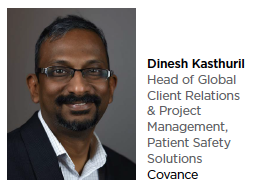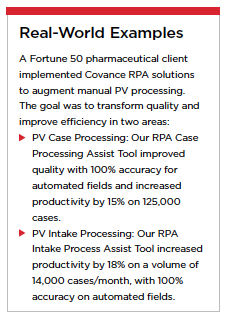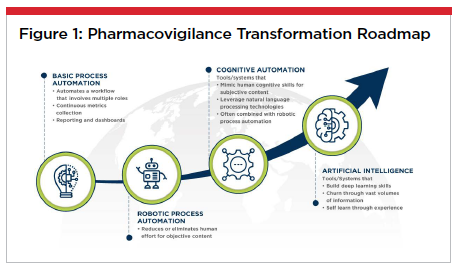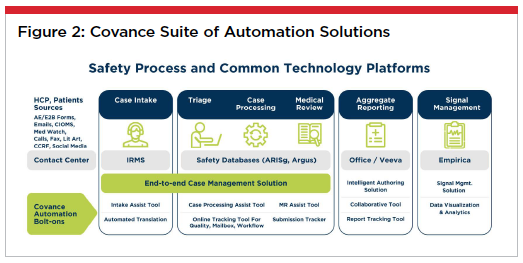Improving Data Quality and Compliance while Reducing Cost with AI
 Traditionally, the pharmacovigilance (PV) function has been responsible for collecting, assessing, and reporting safety information to health authorities, sites, and other stakeholders. Companies have invested in safety systems to gather, organize, and search data. Yet, these closed systems often have lacked the real-time integration and sophistication needed to offer the insights that patients, physicians, providers, and regulators demand. Technology and automation, including AI, will enable the transformation to more personalized and proactive PV. This article discusses the complex journey.
Traditionally, the pharmacovigilance (PV) function has been responsible for collecting, assessing, and reporting safety information to health authorities, sites, and other stakeholders. Companies have invested in safety systems to gather, organize, and search data. Yet, these closed systems often have lacked the real-time integration and sophistication needed to offer the insights that patients, physicians, providers, and regulators demand. Technology and automation, including AI, will enable the transformation to more personalized and proactive PV. This article discusses the complex journey.
Technology Across the Value Chain
Regulators are exploring technology concepts across the pharmaceutical value chain. For example, the FDA recently permitted devices for detecting diabetes and predicting the chances of a stroke based on cognitive technology1. The agency has also indicated an openness to using AI-driven tools and technologies to support new platforms2. Another initiative is the WEB-RADR, an EU-wide mobile phone app enabling users to report adverse drug reactions (ADRs) directly to the national competent authority. These efforts have shown progress in improving both data quality and greater insight by leveraging technology.
 There are significant gains from machine learning and AI-based automation tools, which offer solutions to challenges that existing systems cannot solve. For example, the cost and volume of individual case safety reports (ICSRs) increase yearly3, but it is estimated that more than 90% of adverse events (AEs) go unreported4. The uptick in informal reporting, especially from social media, has encouraged pharmaceutical companies to look for cost-effective solutions to handle structured and unstructured AE data. As reports indicate that ICSR processing contributes to 50% of PV spending,5 there is justifiable interest in automation technologies.
There are significant gains from machine learning and AI-based automation tools, which offer solutions to challenges that existing systems cannot solve. For example, the cost and volume of individual case safety reports (ICSRs) increase yearly3, but it is estimated that more than 90% of adverse events (AEs) go unreported4. The uptick in informal reporting, especially from social media, has encouraged pharmaceutical companies to look for cost-effective solutions to handle structured and unstructured AE data. As reports indicate that ICSR processing contributes to 50% of PV spending,5 there is justifiable interest in automation technologies.
Transforming PV
As of today, despite safety databases, significant components of PV operations are effort-intensive and spreadsheet-driven. The industry lacks integrated solutions that combine activities such as case prioritization and processing, aggregate reporting, and signal detection.
Automation offers significant operational and strategic benefits, but full transformation entails a multi-year journey leveraging various technologies as outlined in this transformation roadmap (Figure 1).
 Basic process automation involves tracking and monitoring tasks with continuous metrics collection and real-time reporting. The benefit is increased efficiency in time- and cost-savings.
Basic process automation involves tracking and monitoring tasks with continuous metrics collection and real-time reporting. The benefit is increased efficiency in time- and cost-savings.
Robotic process automation (RPA) helps reduce manual effort and errors, resulting in automated data entry for objective information in structured formats. Benefits include increased quality and efficiency.
Cognitive automation leverages natural language processing (NLP) to help humans make decisions, often combined with RPA. Cognitive computing automates subjective content and supplements human efforts for data interpretation. A key benefit is increased medical insights but note that cognitive intelligence may still require human interaction.
Artificial intelligence (AI) is envisioned to be more independent and predictive by leveraging large volumes of information. Machine learning, a subset of AI, enables data scientists and analysts to construct algorithms that can learn and make predictions based on data. Deep learning takes this idea further, processing information in layers where the output from one layer becomes the input for the next one. The benefit is an increased focus on proactive PV.
 Leveraging the technologies mentioned in the transformation roadmap (Figure 1), Covance has deployed and continues to build on a suite of automation solutions (Figure 2) across the PV spectrum towards one-touch case processing, intelligent authoring and proactive signal management. These solutions are validated and work seamlessly with safety databases.
Leveraging the technologies mentioned in the transformation roadmap (Figure 1), Covance has deployed and continues to build on a suite of automation solutions (Figure 2) across the PV spectrum towards one-touch case processing, intelligent authoring and proactive signal management. These solutions are validated and work seamlessly with safety databases.
Today, we leverage these solutions across multiple clients, resulting in efficiency improvements of about 25% for the processes where they are deployed.
Envisioning the Future of PV
Covance has a vision of bringing value to patient safety by leveraging delivery excellence, automation capabilities, process transformation expertise and use of analytics on real-time data.
For the past few years, we have been partnering with clients to develop automation solutions by streamlining processes, rapidly prototyping automation tools and successfully deploying solutions with short cycle times.
These solutions have provided efficiency gains of approximately 15-25% over two years, resulting in over a million dollars in savings for clients while improving case quality scores.
In the next phase of this journey, we anticipate benefits from leveraging AI-enabled solutions specifically to interpret subjective information mimicking human intelligence during case processing and auto-assessing ICSR validity for literature cases. For authoring, we are employing machine learning and natural language processing to auto-generating key sections of the aggregate reports. For the signaling, we are looking at external real-world data sources aided by visualization and real-time analysis.
Long term, we are working toward a platform that integrates real-world data sources such as lab data and medical records, which in real time curates and identifies potential ADRs from this data. Cases identified would undergo a physician’s assessment to drive both regulatory reporting and real-time signal detection. Both the data sources and technology to enable this are real and achievable today. These solutions would also be extended to prescribing physicians, allowing them to make better decisions and develop a tailored and personalized treatment plan based on both the patient’s medical history and real-time data from other patients.
This vision moves beyond understanding safety-related problems to transformational PV: a next-generation, patient-centric system that uses deep learning to improve a product’s benefit-risk profile, help patients select an optimal treatment, and enhance patient safety.(PV)
References:
1. fda.gov/news-events/press-announcements/fda-
permits-marketing-artificial-intelligence-based-device-detect-certain-diabetes-related-eye
2. fda.gov/news-events/press-announcements/fda-permits-marketing-clinical-decision-support-software-alerting-providers-potential-stroke
3. windwardstudios.com/white-papers/existing-functions-of-pharmacovigilance-system
4. Mockute, R., Desai, S., Perera, S. et al. Artificial Intelligence Within Pharmacovigilance: A Means to Identify Cognitive Services and the Framework for Their Validation. Pharm Med 33, 109–120 (2019). doi.org/10.1007/s40290-019-00269-0
5. navitaslifesciences.com/implementing-ai-and-robotics-in-pv-a-practical-approach
Covance is a business segment of LabCorp, a leading global life sciences company, which provides contract research services to the drug, medical device and diagnostics, crop protection and chemical industries. Employing over 21,000 people worldwide, we are the world’s most comprehensive CRO, dedicated to improving health and improving lives.
For more information, visit covance.com.



















